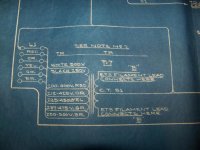gleek
Aluminum
- Joined
- Feb 28, 2012
- Location
- cookeville,tn
First I'd like to thank everyone that helped getting my MG up to speed.Just had it sold while away(long story not needed).
Anyway I knew where there was another Monarch EE (45878)was tucked away and it's in my shop now.
From all the threads I've looked through it's a Wiad (1962). I'm sure with some HELP this sweethart will run for another 50 years.
although when I put the power to it,the main contactor won't stay pulled in,also the 3amp fuse is blown every time I atempt to push the"Control on"switch.I've wired 220 single phase(L1 and L3) I don't have a pump so it looks like L2 isn't used.I have the original electrical blueprints,they were still in there from 1962.This is a good thing,but,I look like the RCA dog staring at the speaker when I look at these prints.WHAT is a FA or a FL for starters? Should the FL close before main contactor can pull in and what kind of a gap should these contacts have? Mine is about 3/16
Also at start-up the tubes heat up but they don't"glow",is this another problem??
Being a mental midget when it comes to electricity is there any procedure out there to start checking like a checklist until you find the problems or just every component one at a time.
thanks
Gleek
Anyway I knew where there was another Monarch EE (45878)was tucked away and it's in my shop now.
From all the threads I've looked through it's a Wiad (1962). I'm sure with some HELP this sweethart will run for another 50 years.
although when I put the power to it,the main contactor won't stay pulled in,also the 3amp fuse is blown every time I atempt to push the"Control on"switch.I've wired 220 single phase(L1 and L3) I don't have a pump so it looks like L2 isn't used.I have the original electrical blueprints,they were still in there from 1962.This is a good thing,but,I look like the RCA dog staring at the speaker when I look at these prints.WHAT is a FA or a FL for starters? Should the FL close before main contactor can pull in and what kind of a gap should these contacts have? Mine is about 3/16
Also at start-up the tubes heat up but they don't"glow",is this another problem??
Being a mental midget when it comes to electricity is there any procedure out there to start checking like a checklist until you find the problems or just every component one at a time.
thanks
Gleek






